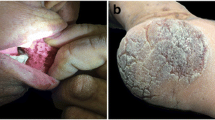Summary
The pathogenesis of cutaneous paraneoplastic syndromes is still under discussion. Since many of these syndromes, including acanthosis nigricans, are proliferative skin disorders it is believed that products secreted by the tumour stimulate the keratinocytes to proliferate. Growth factors like transforming growth factor alpha (TGF-alpha) are known to be highly mitogenic for keratinocytes in vitro. Here we report on a patient with a poorly differentiated gastric cancer and a full clinical picture of acanthosis nigricans characterized by diffuse hyperkeratosis and multiple papillomatous lesions of the skin with involvement of the conjunctivae. In Southern blot analysis of the tumour tissue from this patient amplification of the epidermal growth factor (EGF) receptor, the common ligand for TGF-alpha and EGF, was shown. Immunohistochemically, prominent staining was found throughout the tumour using anti-TGF-alpha antibodies. In a series of 25 investigated gastric tumour biopsies, four tumours showed amplification of the EGF receptor and one additional biopsy was positive for TGF-alpha. Since there is no other report describing the link between TGF-alpha and acanthosis nigricans, except that of Ellis et al. 1987, we present a new case suggesting a possible link between growth factors and acanthosis nigricans maligna.
Similar content being viewed by others
References
Brown J, Winkelmann RK (1968) Acanthosis nigricans: a study of 90 cases. Medicine 47: 33–51
Coffey RJ, Derynck R, Wilcox JN, Bringmann TS, Goustin AS, Moses HL, Pittelkow MR (1987) Production and autoinduction of transforming growth factor-alpha in human keratinocytes. Nature 328: 817–820
Curth HO (1979) Classification of acanthosis nigricans. Int J Dermatol 15: 592–593
Derynck R (1988) Transforming growth factor alpha. Cell 54: 593–595
Ellis DL, Kafka SP, Chow JC, Nanney LB, Inmann WH, McCadden ME, King LE (1987) Melanoma, growth factors, acanthosis nigricans, the sign of Leser-Trelat and multiple acrochordons. N Engl J Med 317: 1582–1587
Falco JP, Baylin SB, Lupu R, Borges M, Nelkin BD, Jasti RK, Davidson NE, Mabry M (1990) v-rasH induces non-small cell phenotype, with associated growth factors and receptors, in small cell lung cancer cell line. J Clin Invest 85: 1740–1745
Gheerart P, Goens J, Schwartz RA, Lambert WC, Schroeder F, Debusscher L (1991) Florid cutaneous papillomatosis, malignant acanthosis nigricans, and pulmonary squamous cell carcinoma. Int J Dermatol 30: 193–197
Gottlieb AB, Chang CK, Posnet DN, Fanelli B, Tam JP (1988) Detection of transforming growth factor alpha in normal, malignant, and hyperproliferative human keratinocytes. J Exp Med 167: 670–675
Gross G, Pfister H, Hellenthal B, Hagedorn M (1984) Acanthosis nigricans maligna. Dermatologica 168: 265–272
Hage E, Hage J (1977) Malignant acanthosis nigricans: a para-endocrine syndrome. Acta Derm Venereol (Stockh) 57: 169–172
Janier M, Blanchet-Bardon C, Bonvalet D, Lenoble M, Boiget F, Civatte J (1988) Three malignant acanthosis nigricans associated with non-Hodgkin's lymphoma. Report on two cases. Dermatologica 176: 133–137
Janovsky V (1890) Acanthosis nigricans. In: Unna PG, Morris M, Besnier E, et al (eds) International atlas of rare skin diseases (part 4). HK Lewis, London, p 1
King LE, Gates RE, Stoschek CM, Nanney LB (1990) The EGF/TGF-alpha receptor in skin. J Invest Dermatol 94: 164–170
Mikhail GR, Fachnie DM, Drukker BH, Farah R, Allen HM (1979) Generalized malignant acanthosis nigricans. Arch Dermatol 115: 201–202
Nanney LB, Ellis DL, Dale B, Stoscheck CM, Holbrook KA, King LE (1988) Epidermal growth factor receptors in idiopathic and virally induced hyperproliferative skin diseases. Clin Res 36: 678A
Nomachi K, Mori M, Matsuda N (1989) Improvement of oral lesions associated with malignant acanthosis nigricans after treatment of lung cancer. Oral Surg Oral Med Oral Pathol 68: 74–79
Pollitzer S (1890) Acanthosis nigricans. In: Unna PG, Morris M, Besnier E et al (eds) International atlas of rare skin diseases (part 4). HK Lewis, London, p 6
Ullrich A, Coussens L, Hayflick JS, Dull TJ, Gray A, Tam AW, Lee J, Yarden Y, Libermann TA, Schlessinger J, Downward J, Mayes ELV, Whittle N, Waterfield MD, Seeburg PH (1984) Human epidermal growth factor receptor cDNA sequence and aberrant expression of the amplified gene in A431 epidermoid carcinoma cells. Nature 309: 418–423
Yoshida K, Yasui W, Ito H, Tahare E (1990) Growth factors in progression of human esophageal and gastric carcinomas. Exp Pathol 40: 291–300
Author information
Authors and Affiliations
Rights and permissions
About this article
Cite this article
Wilgenbus, K., Lentner, A., Kuckelkorn, R. et al. Further evidence that acanthosis nigricans maligna is linked to enhanced secretion by the tumour of transforming growth factor alpha. Arch Dermatol Res 284, 266–270 (1992). https://doi.org/10.1007/BF00372579
Received:
Issue Date:
DOI: https://doi.org/10.1007/BF00372579




